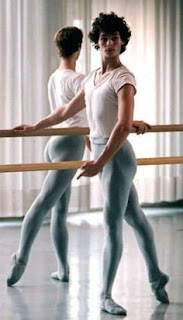 |
| source. |
In many cases, you will see a dancer's or cheerleader's postural habit when they are not dancing or practicing. There are variations on the lack of the postural plumb line, which is a line going straight down through the body, through the natural curves of the neck and spine.
Ideally, the ankles, knees, hips, waist, and shoulders are all stacked neatly.
A tight area in the psoas, one of the large muscles that lifts the legs to the front, will pull the low back out of alignment. The back will look swayed, and the thighs will turn inward.
This is one way that leads to imbalance in the development of the hip muscles. A dancer or cheerleader will try to resolve this with more and more stretching.
Yet, one muscle or another will get tighter and tighter, and others may get over-stretched.
Some students will feel a clicking, a snapping, or a clunky movement for a long time before it starts to hurt. Please tell your teacher or coach immediately if you feel these things.
You can correct your posture and how you use your core and hip muscles, before you get the inflammation and pain that is so hard to get rid of.
Misalignment in the basic posture, and in the basic ballet positions (used everywhere in dance), will develop one muscle or area of muscles too much.
Consequently, other muscles in the same group remain underdeveloped and weak.
Understanding the muscles around the hips, and how they work in connection with the deep low core muscles, will help students or dance team members prevent injuries.
Can you stand sideways to a mirror and check your posture? Can you see the natural curves of your spine and visualize the plumb line going straight through the curves?
Can you pull up the very low abdominal muscles? Sometimes they can be harder to feel than the higher stomach muscles.
If you are not sure that you are using these low ab muscles properly, try this:
* lie down on the floor, and make sure you have your natural curve at the small of your back
* you should be able to slide your hand under the curve there
* first do this wrong - suck in your stomach so that the small of your back pushes into your hand
* release the stomach muscles
* now do it right - pull your very low ab muscles straight up from your pubic bone and away from your hip bones
* keep the curve in the small of your back
 |
| source. |
If you take contemporary dance classes and study the Martha Graham technique, you know that the contraction movement actually elongates - even though it changes the shape of the spine and DOES push out the curve at the small of the back, it requires that you pull UP the lower core muscles and maintain length in the spine.
The stronger your low ab muscles are, the more fluidity you will have in your ballet movements. For cheer leading too, your core control will be so much better.
Make sure you get the instructional DVD Flexibility Exercises For Athletes. It includes a whole section on sore muscles relief.
Its a shame that a beautiful dance causes so many pain and problems for the dancers who enjoy it.
ReplyDeleteI do agree! Thanks for visiting this post.
ReplyDelete